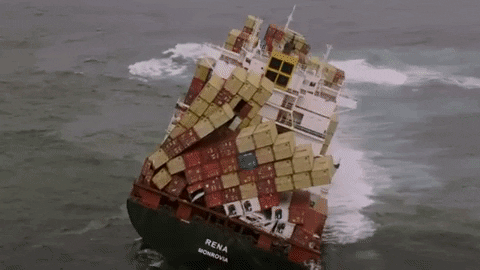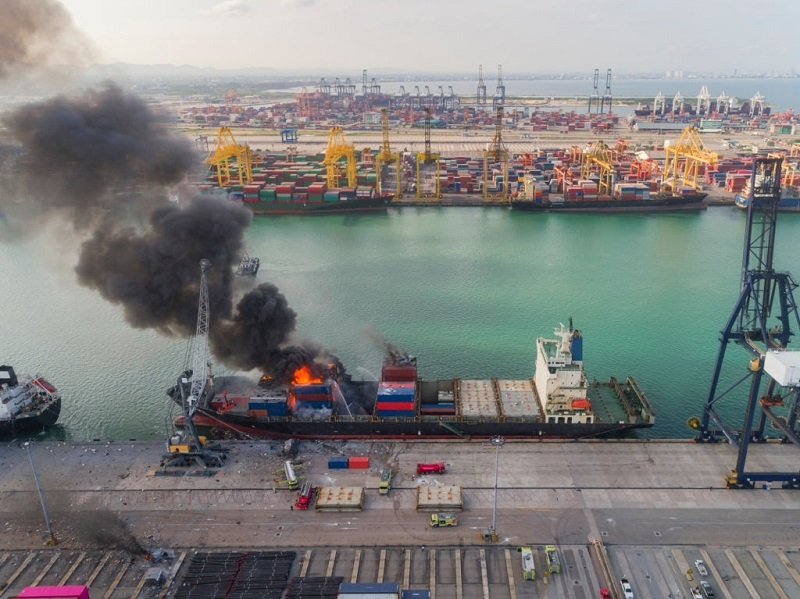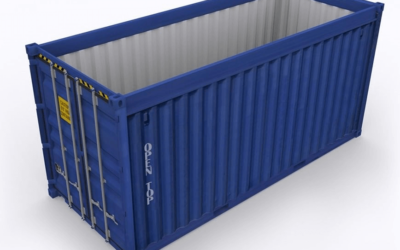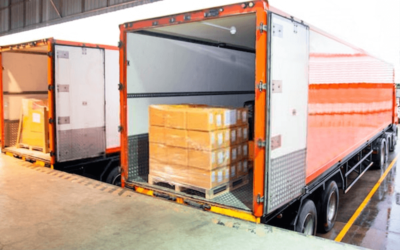What are Freight Claims? [And How to File for One]
Let’s be honest: Shipping isn’t exactly risk-free. Despite your mitigation efforts, your freight will always be at risk of getting damaged or lost. And if worse comes to worst, shippers can always demand reimbursement for lost or damaged shipments by filing freight claims.
Carriers lose shipments more often than you imagine.
For instance, just recently, Maersk lost 750 shipping containers to the depths of the Pacific Ocean. The incident happened on the Maersk Essen, a ship with the capacity of 13,000 containers, that was on its way from Xiamen China, to Los Angeles, California.

The point is – if a shipping company as reputable as Maersk can lose so much freight, as a shipper or consignee, you should know your options and be prepared for the worst.
If you want to know what to do in case your carrier messes up, keep reading.
In this guide, we’ll take you through everything you need to know about freight claims, the different types of claims, and how to file for one.
Let’s get started.
Table of Contents
Freight Damage:
First, you have to understand what freight damage is. It is actually a loss that happened to the shipment due to any mishap. This is possible either due to carelessness or even a natural mishap. But it is possible still to recover your loss through freight claim.
What are Freight Claims?
A freight claim – also known as a damage claim, cargo claim, transportation claim, or shipping claim – is a legal demand made by a consignee or a shipper to their carrier for reimbursement for damaged, missing, or lost shipment.
A claim constitutes complete details of the damage, delivery information, a formal demand for reimbursement, and supporting documents.
By filing a freight claim, the claimant (who can either be the shipper or the consignee), confirms the damage, holds the carrier responsible for the missing or damaged products, and tries to recover all or at least some amount they lost as a result of the carrier’s negligence.
Strictly speaking in legal terms, freight claims are supposed to be initiated when the carrier fails to fulfill their tasks as stated in the bill of lading (BOL).
Here are the different scenarios when you should file for a freight claim (we’ll go into more depth shortly):
- The shipment is visibly damaged
- When upon inspection, you notice that some or all of the shipment is missing
If the carrier doesn’t respond to or refuses your claim, and you have reason to believe that they should reimburse you for the breach of contract, you can take legal action against them. Every government has its own laws that govern these claims.
Freight claims are supposed to be filed as soon as possible. A good practice is to inform your carrier before signing the proof of delivery (POD).
Freight Claim for Dummies
This can be explained even in simple language. So here is Freight claim for dummies:
This is usually a legal document submitted by a consignee. He finds out that his shipment is not in its original state or in quantity It is either misplaced or damaged, therefore, he lodges this complaint against the Shipper. This complaint is called a freight claim.
The Different Types of Freight Claims
If you’ve never filed a claim before, you might want to familiarize yourself with the different kinds of shipping claims.
This can help you look in the right places (and use the right vocabulary) when filing.
The different types of freight claims include:
1. Damaged Claim
This is the most common type of freight claim.
As the name suggests, you can file for a damaged claim if the shipment arrives at its final destination in a visibly unusable and/or damaged form.

While you should always inspect your shipment before signing the delivery receipt, you should take special precautionary measures if you notice any tears in the packaging (such as water damage or tears in the shrink wrap).
If your goods are even slightly damaged, you have the right to file a claim.
2. Shortage Claim
Shortage refers to a scenario when only a part of the shipment arrives at the destination.
For instance, let’s say that your carrier had to deliver 10 boxes of spare parts at your facility according to the BOL. However, when the freight arrives, it only includes 7 units.
In such a scenario, you are in the position of filing a freight claim.
3. Loss Claim
In a loss claim, the carrier loses the entire shipment.
Naturally, this is the worst-case scenario from a business perspective as none of the goods make it to their final destination.
This could happen due to a number of reasons, one of which is theft.
At times, this happens when carriers misplace the cargo. To that end, they usually get a grace period of a week to try and locate the goods.
If the carrier is unable to locate your shipment after the grace period, you can file for a claim.
4. Concealed Damage
At times, the consignee doesn’t notice the damage until after receiving the delivery, which means that they’re not mentioned on the POD.
In such a scenario, the shipper would have the option of filing for a concealed damage claim.
Naturally, filing these claims can be a bit tricky.
Carriers usually provide a 5-day window to file these claims, after which, they’re very likely to deny the claim.
5. Concealed Shortage
Similar to concealed damages, concealed shortage claims are filed when the consignee notices that some of the shipment is missing until after signing the delivery receipt.
Again, in such a case, you should let the carrier know within 5 days and file a claim.
6. Refused Claim
In addition to freight damages, shortages, or losses, a consignee can also object to a shipment if it arrives late or if they receive the wrong goods.
If you’re the one sending shipments, and the consignee refuses delivery, it’s returned to your carrier’s terminal.
Freight Claim Procedure
It is important to know the proper freight claim procedure in order to recover your loss. Here we provide you an effective guide to recover your loss.
How to File Freight Claims?
Filing claims can be a tricky business, especially if it’s your first time doing this.
However, if you take the appropriate precautionary measures, and take the right steps at the right time, you can significantly improve the likelihood of getting reimbursed for any damages.
Let’s go through the steps, one at a time:
1. Start by Closely Inspecting the Goods
Before anything else, you should always closely inspect your goods at the time of delivery.
Only sign the proof of delivery if you’ve made sure that the freight is in good condition (and not having parts of it missing).
If not, you should investigate further and figure out the complete extent of the loss or the damage, so that you can later calculate them as accurately as possible.
2. Inform the Carrier Immediately
Once you discover any damaged or missing products, you should inform your carrier immediately (ideally on the date of delivery).
First and foremost, you should highlight the damages in the POD.
Secondly, you should formally inform the carrier about the potential damages. This is especially true if you’re planning on filing for a shortage or loss claim. This will give the carrier ample time to try to locate the missing goods in their warehouses.
Finally, make sure that you pay the freight bill to avoid any unnecessary delays from the carrier’s end.
3. File the Claim Immediately
The only thing left to do is to file your claim.
While there aren’t any strict time limits, you should file your freight claims as soon as possible.
Below, we’ve answered some common questions that arise when filing them for the first time:
Are There Any Specific Documents I Need to File a Freight Claim?
First and foremost, you need some supporting documents that will make your claim airtight and improve your odds of getting reimbursed.
While there are no specific requirements, you should definitely have the following documents on hand:
- A freight claim form
- The original bill of lading
- A paid freight bill/receipt including the details of freight charges
- Photographs for evidence (for both damage and shortage claims)
- A proof of the value of the goods that were damaged or went missing
- A notification of loss
- Waiver of inspection
In addition, add anything else that you feel might make your case stronger and further solidify the negligence of the carrier.
How Do I Calculate My Losses?
A vital component of your freight claim is the amount of money you lost due to the carrier’s negligence.
The calculation should include:
- The full extent of the loss in dollar amount
- Value of the freight (mention units/weights and their cost)
- Details of what you were able to salvage from the damaged freight
In addition, it should include a detailed description of the events that caused the loss. For instance, if you received 5 damaged cartons, 2 of which were crushed and 3 showed signs of water damage, that should be included in your calculation.
Here is an example:
- 5 cartons paper water damaged; @ $40 ea. = $200
- 10 cartons printer ink missing; @ $600 ea. = $6,000
- 5 cartons packing sheets crushed; @ $30 ea. = $150
- Total Cost of damages and lost: $200 + $6,000 + $150 = $6,350
- Less Salvage: ($1,200)
- Amount of Freight Claim: $5,150
The method shown above works best as it leaves no room for confusion.
What happens to damaged freight?
Now you must be thinking that what about the damaged freight and what happens to it. So don’t worry, we have got the answers to all those possible questions in your mind.
What Should I Do with the Damaged Freight?
If you’re filing a freight claim, you may refuse to accept the damaged freight.
However, if you accept the damaged shipment, you must hold on to it. Do NOT throw away the freight until the dispute is resolved.
As a part of the process, carriers have to closely inspect the shipment to confirm the extent of the damage and see what they can salvage.
How Long Does the Process Usually Take?
The short answer – it depends.
Since the laws governing freight claims vary from country to country, there’s no straight answer.
However, a good practice is to wait for at least 30 days after filing your claim to follow up with the carrier.
For shipments transported from the US to adjacent countries, the carriers have a window of 30 days to acknowledge the freight claim (as per the Carmack Amendment).
If you don’t hear back from your carrier, you may go ahead and ask for a follow-up or initiate legal proceedings as per your country’s laws.
What to do if the Carrier Denies Liability?
If your carrier denies liability, you can consider submitting additional documents to get through to them.
If they still refuse to pay, you may proceed to file a lawsuit against them.
If you want tips to put such a burden off your shoulders then the following information is important about how to reduce damage claim
This is how to do it:
First and foremost you must take care of your manner of wrapping up your items. This means you should keep it in secure packaging. Re-inspect it so that nothing happens to it onboard. And make sure the labels you paste over it provide clear information like a destination. This can reduce the possibility of getting lost.
Now as you have packed them safely and labeled them clearly it is important to place them well. So that they don’t stumble down. And in the end, make sure the freight forwarder is reliable.
Minimize Damage Risks by Choosing a Reliable Freight Forwarder
As mentioned earlier, your freight will always be at risk of getting damaged or lost.
But you can take some precautionary measures to minimize that risk as much as possible so that you don’t have to worry about filing transportation claims in the first place.
A good practice would be reducing risk with a freight forwarder, specifically one that has:
- Good reviews
- A transparent process
- Partnerships with trustworthy carriers
In addition, a reliable freight carrier can also help you navigate the tricky waters of marine insurance, including how to effectively file for an insurance claim if needed.
Qafila ticks all of those boxes. Not only do we partner with reliable carriers, including Hapag-Lloyd, Emirates SkyCargo, Etihad, Maersk, and DHL, among others, but we also offer complete transparency.
Thanks to our cutting-edge platform, you’ll be able to track your freight throughout the shipment process at all times. Learn more about how we can help book, ship, and manage your supply chain online.






